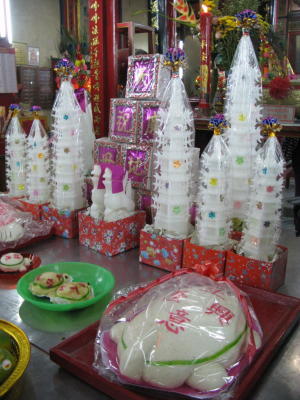
Published caption : This shrine, in Talat Noi, Samphanthawong district, is dedicated to the memory of a Buddhist monk named Cho Su Kong who was celebrated for his ability to cure illness and disease. He is said to have been born in Yongchun, in China’s Fujian province, back in 1047. While the exact date of its construction is unknown, an inscription over the statue in the middle of the shrine mentions the year 1804, which was five years prior to the death of King Rama I. The shrine contains examples of the religious art and culture of the Hokkienspeaking immigrants who probably paid to have it erected, including poems, mural paintings, sculptures and carvings. On the day before the full Moon in the third month of the Chinese lunar calendar, the shrine hosts the Wai Kanom Tao Festival. Worshippers bring Chinese buns (kanom ) baked in the shape of turtles (tao in Thai), with red and green dots on their backs, to propitiate the sprit of Cho Su Kong and the various Mahayana Buddhist deities and sages honoured there. The custom is to write a wish-list on a sheet of paper, roll it into a tight scroll and then deposit it in a little room behind the statues. By so doing, it is believed that one’s wishes will come true.
|